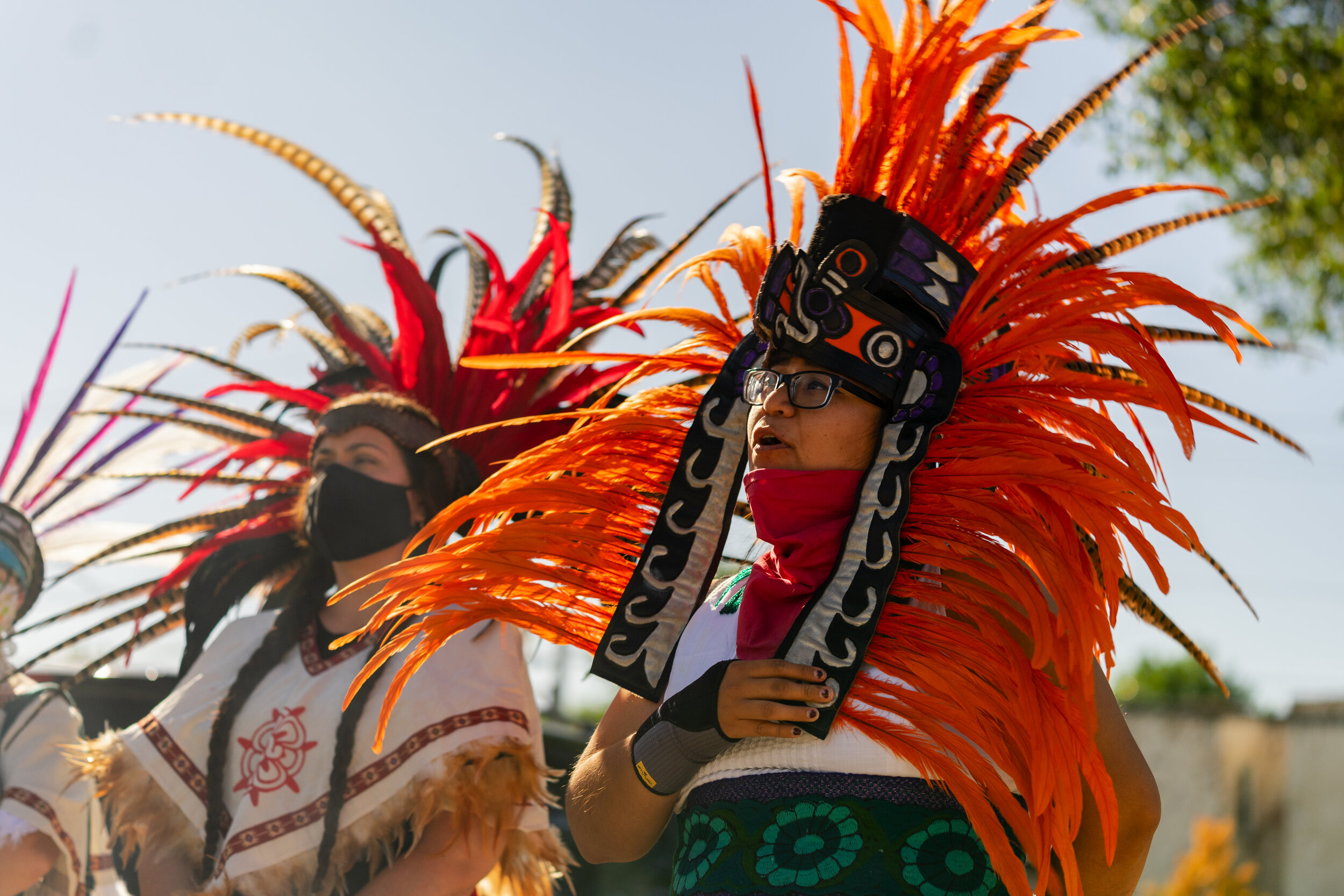The power of Indigenous rituals: Aztec and African ancestral dancers join forces to bridge Lawndale, Little Village neighborhoods
By Laura Rodriguez Presa
CHICAGO TRIBUNE | SEP 09, 2020 AT 3:28 PM
The scent of burning copal filled the air as Aztec dancers, bedecked in feathered headdresses and wearing shell-embellished ankle cuffs, blessed an intersection bordering Little Village and North Lawndale on a sunny morning in September. The group was getting ready to perform a Mexican ancestral prayer followed by a traditional West African ritual by African American dancers also wearing their vivid traditional textiles.
The two groups gathered Saturday to embrace and showcase each other’s ancestral ceremonies, as part of a series of similar events held since 2018 to celebrate Black and Latino unity, and to address anti-Blackness in the Latino community.
This time, the beat of the drums resonated on the corner of Lawndale and Ogden avenues, the division line between Lawndale, a predominantly Black neighborhood, and Little Village, a Mexican-American community.
A mural of Martin Luther King Jr. and Cesar Chavez stands near where Saturday’s ceremony took place. The site was chosen so members of each community could see it and feel encouraged to participate, said Henry Cervantes, leader of Xochitl-Quetzal Aztec Dance and organizer of the collaboration between Black and Latino Indigenous dance groups to address the racial tension between the two communities.
“We are facing a double pandemic, the health pandemic but also a pandemic of racism,” Cervantes said in Spanish.
An Aztec dancer walked around blessing with copal the members of Najwa Dance Corps of Chicago, dedicated to reflecting the African American dance heritage; and the members of Example Setters, a Black youth poetry group. The two groups partook in the later healing ceremony and celebration.
For over three years, Cervantes’ dance group has collaborated with various African and other Aztec dance groups to perform their Indigenous rituals side by side in communities affected by violence, to try to help them find healing.
The first-ever ceremony in 2018 was in Back of the Yards with Ayodele Drum and Dance, an all-women’s African dance group, and Example Setters. In 2019, the healing ritual took place in Little Village with the Drum Divas, an African American women’s drumming group, and with African Explosion. In August, another ceremony was held in Garfield Park with Najwa Dance Corps. Each features a healing circle and conversation after the ceremony.
“These are two cultures living side by side, and we are more similar than we think,” Cervantes said.
“But the divide has always been stronger because racism and colorism are embedded in our culture, and we need to challenge ourselves to stop with the racism and prejudice that sometimes Mexicans have against Black people,” he added.
Cervantes believes showing the community the similarities between the two cultures can help to create understanding and authentic unity between Black people and Mexicans.
“By sharing culture, song, dance and dialogue, then we begin to learn about the other. That way, we stop seeing them (Black people) as the other; instead, we learn to see ourselves in them,” Cervantes explained.
The need to address anti-Blackness within the Latino community became more urgent in Chicago and around the country after George Floyd was killed by police and officers were charged with murder in Minnesota in late May, Cervantes said.
And the need for the Danzas concheras to participate in marches and protests also became more evident.
“These aren’t dances or shows, these are our prayers,” said Sandra Payan Cataño, a dancer who has participated in various Black and brown Indigenous dance rituals with Cervantes.
The purpose of their attending protests and marches is to make their presence visible, share their energy, stand in solidarity with others and create community, she explained. That’s how they have fought for social justice.
“Each movement and each dance is a different prayer, our outfit has a meaning. When we participate in a demonstration, we call on the universe for strength and clarity.”
The roots of the Aztec Indigenous rite, also known as Mexica and Chichimeca, include traditions from prior to Spanish colonization and Christian traditions from colonial Mexico. It was an ancient religious ceremony that in the 20th century became a symbol of Mexican Indigenous culture. Now, the dancers popularly known as concheros carry on the tradition.
Each piece of clothing the concheros use — featuring feathers, beadwork and headdresses — and their dance movements, honor ancestors, deities and the cosmos. The rhythm is made of different instruments including drums, flutes, maracas and shell ankle rattles.
Some drums are similar to the ones used for the African ancient dances, said Andrea “Najwii” Vinson, a member of the Najwa Dance Corps of Chicago, which has participated in the Black and brown Indigenous healing ceremony over the past years.
“Beyond the protests, it’s a blessing that we are having these conversations now and seeing that we share more similarities than differences,” Vinson added. “We can see each other’s struggle, and we can understand that we are fighting for the same thing.”
Acknowledging and accepting anti-Blackness is the first step to battle racism, and creating safe spaces to bring Black and Latino people together for dialogue sets the discussion in motion, Cervantes said.
“In these barrios there exists great power, in the cultural and traditional sense,” Cervantes said.
“What people saw today is the energy and history that exists in our neighborhood within each other, but we need to recognize it,” Cervantes said after the dancers finished their ceremony. “We need to honor each other’s history.”
Laura Rodríguez Presa
CONTACT
Laura Rodríguez Presa is a bilingual journalist covering the Latino community in the Chicago area. Formerly a multimedia reporter for Hoy, the Tribune’s Spanish-language newspaper, Laura focused on exposing the often untold stories of the Latino community. She aims to write pieces that transcend language, race, age and gender barriers.


